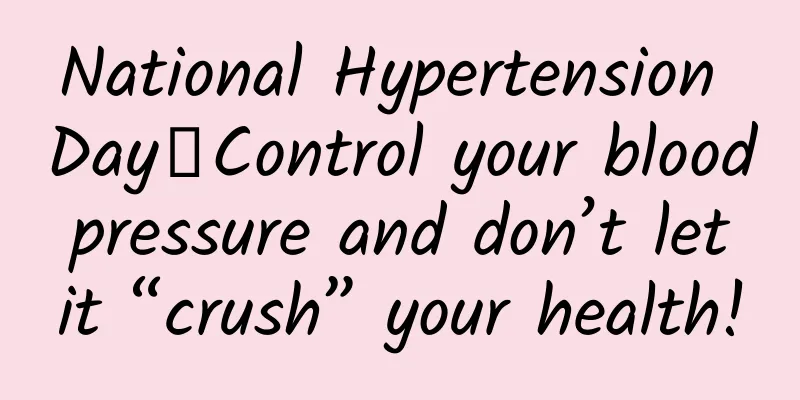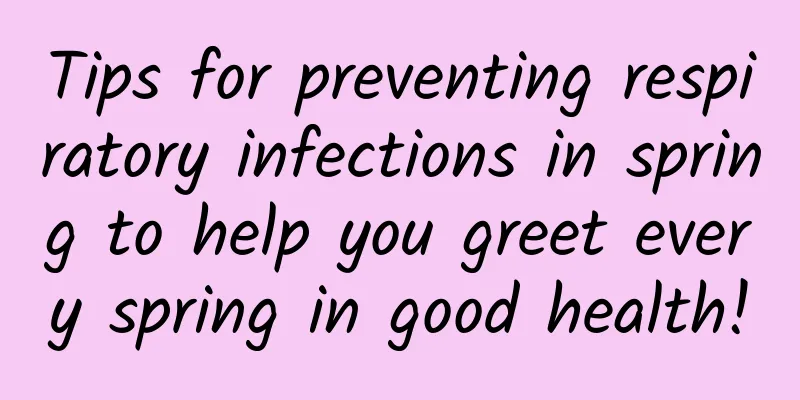National Hypertension Day丨Control your blood pressure and don’t let it “crush” your health!

|
Author: Wang Changyuan, Chief Physician, Xuanwu Hospital, Capital Medical University Reviewer: He Jingyu, Chief Physician, Xuanwu Hospital, Capital Medical University Hypertension is a common cardiovascular disease in clinical practice and a risk factor for coronary heart disease, stroke and other diseases. Currently, the number of people suffering from hypertension worldwide has reached 1.28 billion. There are about 245 million hypertensive patients in my country, with a prevalence of 27.9% for those over 18 years old and about 90% for those 80 years old or older. However, the control rate of hypertension is only 16.8%. Hypertension can lead to cardiac hypertrophy, heart failure, cerebral hemorrhage, cerebral infarction and uremia, which seriously affect the patient's physical health and quality of life and consume huge medical resources. Therefore, early identification of hypertension, standardized treatment and control of blood pressure are a strong guarantee for a healthy life. Figure 1 Copyright image, no permission to reprint 1. Diagnosis and clinical manifestations of hypertension Blood pressure refers to the lateral pressure of blood on the blood vessel wall when blood flows in the blood vessels, including systolic pressure and diastolic pressure. Normal systolic pressure is less than 120mmHg, and diastolic pressure is less than 80mmHg. Hypertension refers to systolic blood pressure ≥140 and/or diastolic blood pressure ≥90mmHg in the clinic for three different days in an adult without the use of antihypertensive drugs. The clinical manifestations of hypertension lack specificity, and often there are no symptoms or the symptoms are atypical, including dizziness, headache, chest tightness, palpitations, tinnitus, etc. When blood pressure rises sharply in a short period of time and a hypertensive emergency occurs, it will seriously harm the heart, kidneys, brain and other organs, and the patient will show symptoms such as difficulty breathing, chest pain, nausea, vomiting and changes in consciousness. 2. Accurate measurement of blood pressure Blood pressure measurement is an effective means to assess blood pressure levels, diagnose hypertension and monitor the effect of blood pressure control. Blood pressure measurement mainly includes office blood pressure measurement and out-of-office blood pressure measurement. Office blood pressure is measured by medical staff under standard conditions according to unified standards. It is currently a common method for diagnosing hypertension and grading blood pressure levels. The patient rests for at least 5 minutes and uses an electronic or mercury sphygmomanometer to measure the blood pressure of the upper arm brachial artery in a sitting position. Generally, the blood pressure is measured 2 to 3 times and the average value is taken. Out-of-office blood pressure measurement includes home blood pressure monitoring and dynamic blood pressure monitoring. Home blood pressure monitoring can help identify white coat hypertension and concealed hypertension and is one of the effective methods for long-term follow-up. For patients with newly diagnosed hypertension or patients with unstable blood pressure, it is recommended to measure blood pressure at home every morning and evening, measure 2 to 3 times each time, take the average value, measure continuously for 7 days, and record in detail. The number of measurements can be appropriately reduced after the blood pressure stabilizes. When taking oral antihypertensive drugs, blood pressure should be measured before taking the medicine and before meals. Avoid drinking hot water and strenuous exercise 30 minutes before measuring blood pressure, empty the bladder, relax your mind and avoid tension. Figure 2 Copyright image, no permission to reprint Dynamic blood pressure monitoring is an indirect non-invasive measurement method that is used continuously for 24 hours. It can reflect the changes and trends of patients' blood pressure during the day and night, and can effectively identify white coat hypertension, masked hypertension, and diagnose simple nocturnal hypertension. During dynamic blood pressure monitoring, it is recommended to maintain normal activities, avoid bathing, and try to stay supine when sleeping. 3. Treatment of hypertension The goal of hypertension treatment is to reduce the incidence of damage to important organs such as the heart, brain, and kidneys and vascular complications, and to reduce mortality. Appropriate treatment plans should be developed based on cardiovascular and cerebrovascular risk factors and target organ damage. First, blood pressure should be lowered by improving the patient's lifestyle, including a low-salt diet with a daily sodium intake of less than 6 grams. When cooking, use less salt, soy sauce, chicken essence, hot sauce, etc., and eat less pickled vegetables, bacon, cured meat, salted fish and other high-salt foods. Eat a reasonable diet, increase fresh fruits and vegetables rich in potassium, eat whole grains, soybeans and nuts, control high-calorie foods, and lose weight. Quit smoking and drinking. If it is difficult to quit drinking, reduce the amount of alcohol or drink a small amount of low-alcohol wine. Increase exercise and maintain a balanced mentality to reduce mental stress. Get enough sleep, have a regular life, and avoid fatigue and emotional stress. Figure 3 Copyright image, no permission to reprint If improving your lifestyle still does not achieve your treatment goals, you should seek medical attention promptly and take antihypertensive drugs for standardized treatment under the guidance of a doctor. References [1] Lou Ying, Ma Wenjun, Wang Zijun, et al. Proposal for clinical practice guidelines for hypertension in China[J]. Chinese Journal of Cardiology, 2022, 50(7): 671-675. [2] Hypertension Branch of Chinese Geriatrics Society, National Clinical Research Center for Geriatric Diseases, and Chinese Alliance for Prevention and Treatment of Cardiovascular Diseases in the Elderly. Guidelines for the Management of Hypertension in the Elderly in China 2019[J]. Chinese Journal of Cardiology, 2019, 24(1): 1-23. |
<<: Suspended "swing", "moon boat" for children's rehabilitation
>>: Osteoporosis in the elderly should not be ignored
Recommend
What is the reason for delayed menstruation when not pregnant?
Menstruation has a great impact on women. In the ...
How many days of pregnancy can you see the gestational sac by ultrasound?
Women will have a gestational sac after they beco...
How much do you know about the nursing care for posture and complications of gynecological laparoscopic surgery?
With the development of surgical technology, lapa...
Women's fat loss and fitness methods
Fat loss and fitness are issues that every girl d...
Does the 15-day abortion leave include weekends?
Pregnancy and childbirth are very happy and joyfu...
What shampoo should girls use if they have severe hair loss?
Everyone will lose hair to some extent. Hair turn...
Can I get pregnant if I don't have sex during my ovulation period?
We still find that many couples go to the hospita...
Can I drink barley porridge when my period comes?
We know that girls have a few days every month du...
What if my period is delayed for 20 days during breastfeeding?
The physiological activities of breastfeeding wom...
13-year-old girl's breasts
13-year-old girls are still in the puberty stage,...
How to check menstrual cycle?
Although many people have heard of the term menst...
How to treat breast pain before menstruation
Many women suffer from headaches and breast pain ...
Different stomach pain symptoms and treatments
The stomach is one of the important digestive org...
How to make hot pot base? Is the hot pot sauce pure sesame oil?
Eating hot pot gives people a warm and team-like ...
What should I do if my wife hasn't had her period yet?
If a married woman does not have her period, she ...









